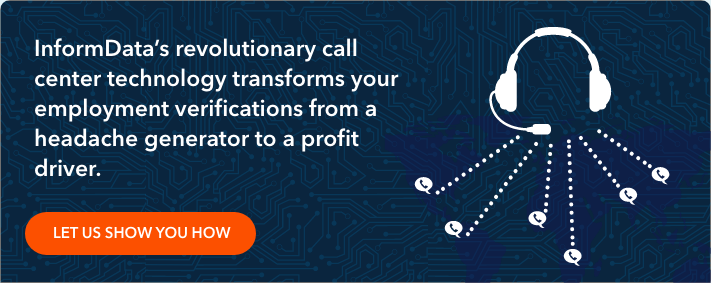When an employer pays for a background check, they naturally expect the whole package: the criminal background check, the drug testing, and of course, the resume verification.
Unfortunately, the complete package is easier said than done — especially resume verification. Sources don’t return calls, applicants provide vague or partial information, and end-users lose their patience.
Along with elevated turnaround times, low completion (or verification) rates for employment verification can severely impact your competitiveness as a CRA or background screening company. End-users rarely understand or accept excuses for failing to verify a job applicant’s work or educational background. Too many incomplete verifications will send a customer looking for another background screening provider.
How can you ensure more of your business’s verification calls conclude with reportable results (and therefore increase your completion rate)? Here are three strategies:
1. Invest in advanced call center technology
The world’s most effective customer service organizations don’t leave anything to chance. Modern call centers are equipped with cutting-edge technology designed to maximize efficiency and get results by routing calls to the right people at the right time. Callers are never expected to improvise; they are guided through each call with carefully-written scripts and dropdown menus.
The same technology also empowers the most successful employment verification call centers.
For example, imagine if, instead of remembering calling patterns for several different clients, your verification team members simply had to follow the prompts on their screens. The calling patterns would be coded into the system. All the documentation a caller would need to complete a verification would be available at the press of a button.
This is possible with state-of-the-art call center technology working behind the scenes to take guesswork, downtime, and inefficiency out of the employment verifications process.
2. Dig into the data
Once you have the technology described above, you can start to amass data — data you can use to further optimize your verification process for higher completion rates. With enough data and proper analysis, you can answer questions such as:
- When is the best time of day to reach a source?
- How much time should you leave between calls to maximize the chance of a response from a source?
- Should you call the provided number, or will another number be more effective?
- Which specific words or phrases are most likely to lead to a quick resolution?
As you gain data-driven insights, you can code them into your calling system, saving your researchers from having to remember complicated, client-specific calling patterns.
Modern call center technology can “remember” a source’s preferences when configured correctly. So, for example, once you’ve learned that a specific source responds to faxes, but not phone calls, the next time that source comes up, your team can save themselves a wasted call and skip right to the fax.
3. Optimize your staffing levels
As you know, the employment market is both seasonal and unpredictable. CRAs often struggle to scale up quickly when the job market takes off (as it has recently). And when hiring slows (as it did at the beginning of the COVID pandemic), CRAs must choose between being overstaffed or being caught flat-footed when hiring picks up again.
Adding to the staffing challenge for CRAs is the fact that onboarding just takes so long. The typical new hire can take six to eight weeks to learn the calling system and the various customizations required for different clients. Meanwhile, while you’re waiting for your new hires to get up to speed, the backlogs pile up, and your completion rate plummets.
Again here, advanced call center technology and the judicious application of data can dramatically shorten the onboarding period.
Because the latest call center technology acts behind the scenes to route calls and feed scripts to callers, working as a verifications researcher is no more difficult than clicking through menus and reading off a screen. Here at InformData, for example, we can train someone essentially off the street to become a proficient verifications researcher within four days.
The data gathered throughout the verifications process can be used to ensure the optimal staffing level at all times. Combined with a speedy onboarding program, this will allow you to maintain and effectively deploy a flexible team of part-time or full-time researchers.
Boost your completion rate by outsourcing verifications
Admittedly, the three solutions shared in this article may not be feasible for all or even most background screening companies. State-of-the-art call center technology requires a significant financial investment, plus the knowledge and experience to configure it properly. As for data-driven insights, many CRAs will simply lack the volume to gather enough meaningful data.
Nevertheless, any CRA can increase their completion rate for verifications by partnering with a data provider with the scale, expertise, and technology to apply the solutions discussed in this article. With the right outsourced provider, you can deliver more complete pre-employment background screening reports — faster — while maintaining the quality and customized service your end-users expect.
Watch this blog for upcoming articles explaining the benefits of outsourcing employment verification work and practical tips for finding the best outsourced data providers.


